Local Perspectives on Climate Change, Its Impact and Adaptation: A Case Study from the Westfjords Region of Iceland
Abstract
1. Introduction
2. Materials and Methods
2.1. Study Area
2.2. Climate Data Collection
2.3. Climate Data Analysis
2.4. Mapping Potential Local Impacts
3. Results
3.1. Temporal Changes in Temperature and Precipitation in the Westfjords
3.2. Spatial Changes in Temperature and Precipitation in the Westfjords
4. Discussion
4.1. Local Climate Change Trends
4.2. Global Changes, Local Consequences
5. Conclusions
Author Contributions
Funding
Acknowledgments
Conflicts of Interest
References
- IPCC. Summary for Policymakers. In Climate Change 2021: The Physical Science Basis. Contribution of Working Group I to the Sixth Assessment Report of the Intergovernmental Panel on Climate Change; Cambridge University Press: Port Melbourne, Australia, 2021; in press. [Google Scholar]
- AMAP. Arctic Climate Change Update 2021: Key Trends and Impacts. Summary for Policy-Makers; Arctic Monitoring and Assessment Programme (AMAP): Tromsø, Norway, 2021; p. 16. [Google Scholar]
- Doney, S.C.; Fabry, V.J.; Feely, R.A.; Kleypas, J.A. Ocean Acidification: The Other CO2 Problem. Annu. Rev. Mar. Sci. 2009, 1, 169–192. [Google Scholar] [CrossRef] [PubMed]
- Perner, K.; Moros, M.; Otterå, O.H.; Blanz, T.; Schneider, R.R.; Jansen, E. An Oceanic Perspective on Greenland’s Recent Freshwater Discharge since 1850. Sci. Rep. 2019, 9, 17680. [Google Scholar] [CrossRef] [PubMed]
- Rocklöv, J.; Dubrow, R. Climate Change: An Enduring Challenge for Vector-Borne Disease Prevention and Control. Nat. Immunol. 2020, 21, 479–483. [Google Scholar] [CrossRef] [PubMed]
- Box, J.E.; Colgan, W.T.; Christensen, T.R.; Schmidt, N.M.; Lund, M.; Parmentier, F.-J.W.; Brown, R.; Bhatt, U.S.; Euskirchen, E.S.; Romanovsky, V.E.; et al. Key Indicators of Arctic Climate Change: 1971–2017. Environ. Res. Lett. 2019, 14, 045010. [Google Scholar] [CrossRef]
- Overland, J.; Dunlea, E.; Box, J.E.; Corell, R.; Forsius, M.; Kattsov, V.; Olsen, M.S.; Pawlak, J.; Reiersen, L.-O.; Wang, M. The Urgency of Arctic Change. Polar Sci. 2019, 21, 6–13. [Google Scholar] [CrossRef]
- Ballew, M.T.; Leiserowitz, A.; Roser-Renouf, C.; Rosenthal, S.A.; Kotcher, J.E.; Marlon, J.R.; Lyon, E.; Goldberg, M.H.; Maibach, E.W. Climate Change in the American Mind: Data, Tools, and Trends. Environ. Sci. Policy Sustain. Dev. 2019, 61, 4–18. [Google Scholar] [CrossRef]
- Whitmarsh, L.; Capstick, S. Perceptions of Climate Change. In Psychology and Climate Change; Elsevier: Amsterdam, The Netherlands, 2018; pp. 13–33. ISBN 978-0-12-813130-5. [Google Scholar]
- Poortinga, W.; Fisher, S.; Bohm, G.; Steg, L.; Whitmarsh, L.; Ogunbode, C. European Attitudes to Climate Change and Energy. Topline Results from Round 8 of the European Social Survey; European Social Survey ERIC: London, UK, 2018. [Google Scholar]
- Jalbert, M.; McClung, J.; Seibert, B.; Yeung, P. Perceptions of Climate Change in Iceland; Worchester Polytechnic Institute: Worcester, MA, USA, 2018. [Google Scholar]
- Statistics Iceland Statistics Iceland: Greenhouse Gas Emissions from Iceland (NIR). Available online: https://statice.is/statistics/environment/emission/greenhouse-gas-emissions-from-iceland/statistics/environment/emission/greenhouse-gas-emissions-from-iceland (accessed on 4 January 2022).
- Chadwick, A.E. Climate Change Communication. Available online: https://oxfordre.com/communication/view/10.1093/acrefore/9780190228613.001.0001/acrefore-9780190228613-e-22 (accessed on 3 January 2022).
- Jones, C.; Hine, D.W.; Marks, A.D.G. The Future Is Now: Reducing Psychological Distance to Increase Public Engagement with Climate Change. Risk Anal. 2017, 37, 331–341. [Google Scholar] [CrossRef]
- Sheppard, S.R.J.; Shaw, A.; Flanders, D.; Burch, S.; Wiek, A.; Carmichael, J.; Robinson, J.; Cohen, S. Future Visioning of Local Climate Change: A Framework for Community Engagement and Planning with Scenarios and Visualisation. Futures 2011, 43, 400–412. [Google Scholar] [CrossRef]
- Crochet, P.; Jóhannesson, T. A Data Set of Gridded Daily Temperature in Iceland, 1949–2010. Jokull 2011, 61, 1–18. [Google Scholar]
- IMO (Icelandic Meteorological Office) Climate Report|Climate of Iceland. Available online: https://en.vedur.is/climatology/iceland/climate-report (accessed on 5 June 2021).
- IPCC. Climate Change 2022 Impacts, Adaptation and Vulnerability; IPCC: Geneva, Switzerland, 2022. [Google Scholar]
- Mauritsen, T.; Pincus, R. Committed Warming Inferred from Observations. Nat. Clim. Chang. 2017, 7, 652–655. [Google Scholar] [CrossRef]
- NLSI (National Land Survey of Iceland) Geodatabase IS50v. Available online: https://www.lmi.is/is/landupplysingar/gagnagrunnar/nidurhal (accessed on 17 March 2022).
- Björnsson, H. Jöklar á Íslandi [Glaciers in Iceland]; Forlagið: Reykjavík, Iceland, 2019. [Google Scholar]
- Þórarinsson, S. Flatarmál Nokkurra Íslenzkra Jökla Samkvæmt Herforingjaráðskortunum. [The Area of Some Icelandic Glaciers According to the Danish General Council Maps]. Jökull 1958, 8, 25. [Google Scholar]
- Icelandic Institute of Natural History Vistgerðir á Íslandi [Habitat Types in Iceland]. Available online: https://vistgerdakort.ni.is/ (accessed on 25 April 2022).
- Botková, K.; Unnsteinsdóttir, E.R. Arctic Fox in Iceland—Protection of Furry Tourist Attraction; Mendel University: Brno, Czech Republic, 2015. [Google Scholar]
- Gardarsson, A. The Density of Seabirds West of Iceland. Rit Fiskid. 1999, 16, 155–169. [Google Scholar]
- Gunnlaugsson, S.B.; Valtysson, H. Sustainability and Wealth Creation, but No Consensus: Recent Decades in Iceland’s ITQ-Managed Fisheries. Mar. Policy 2022, 135, 104836. [Google Scholar] [CrossRef]
- Decaulne, A.; Saemundsson, T. Geomorphic Evidence for Present-Day Snow-Avalanche and Debris-Flow Impact in the Icelandic Westfjords. Geomorphology 2006, 80, 80–93. [Google Scholar] [CrossRef]
- Bjornsson, H.; Jonsson, T.; Gylfadottir, S.; Olason, E. Mapping the Annual Cycle of Temperature in Iceland. Meteorol. Z. 2007, 16, 45–56. [Google Scholar] [CrossRef]
- Decaulne, A. Snow-Avalanche and Debris-Flow Hazards in the Fjords of North-Western Iceland, Mitigation and Prevention. Nat. Hazards 2007, 41, 81–98. [Google Scholar] [CrossRef]
- 3Icelandic Road Administration Road Conditions in the Westfjords. Available online: http://www.road.is/travel-info/road-conditions-and-weather/westfjords-road-conditions-map/ (accessed on 2 February 2022).
- Icelandic Regional Development Institute Íbúafjöldi Sveitarfélaga Og Byggðakjarna (1. Janúar 2022) [Population of Municipalities and Settlements (1 January 2022). Available online: https://www.byggdastofnun.is/is/utgefid-efni/maelabord/ibuafjoldi-1-januar (accessed on 25 April 2022).
- Edvardsdóttir, A.G.; Ólafsdóttir, R.; Williams, A. Wicked Problems, Regional Development and Rural Sustainability: A Case Study from Iceland. Res. Glob. 2022, in press. [Google Scholar]
- ITB (Icelandic Tourism Board) Tourism in Iceland in Figures. Available online: https://www.ferdamalastofa.is/is/tolur-og-utgafur/ferdtjonusta-i-tolum#2020 (accessed on 18 June 2022).
- Hale, B.W. Mapping Potential Environmental Impacts from Tourists Using Data from Social Media: A Case Study in the Westfjords of Iceland. Environ. Manag. 2018, 62, 446–457. [Google Scholar] [CrossRef]
- ITB (Icelandic Tourism Board) Cruise Ship Traffic in Iceland. Available online: https://www.maelabordferdathjonustunnar.is/en/tourists-to-iceland/cruise-ships (accessed on 18 June 2022).
- NLSI (National Land Survey of Iceland) Iceland Digital Elevation Model. Available online: https://atlas.lmi.is/mapview/?application=DEM (accessed on 17 March 2022).
- WMO. WMO Guidelines on the Calculation of Climate Normals; World Meterological Organization: Geneva, Switzerland, 2017; p. 18. [Google Scholar]
- Samanta, S.; Pal, D.K.; Lohar, D.; Pal, B. Interpolation of Climate Variables and Temperature Modeling. Theor. Appl. Climatol. 2012, 107, 35–45. [Google Scholar] [CrossRef]
- Lloyd, C.D. Assessing the Effect of Integrating Elevation Data into the Estimation of Monthly Precipitation in Great Britain. J. Hydrol. 2005, 308, 128–150. [Google Scholar] [CrossRef]
- Haraldsdóttir, S.H.; Ólafsson, H.; Durand, Y.; Giraud, G.; Mérindol, L. A System for Prediction of Avalanche Hazard in the Windy Climate of Iceland. Ann. Glaciol. 2004, 38, 319–324. [Google Scholar] [CrossRef][Green Version]
- Nawri, N. Large-Scale Atmospheric Conditions Associated with Major Avalanche Cycles and Cold Season Weather Hazards in Iceland; Icelandic Meterological Office: Reykjavík, Iceland, 2013; p. 99. [Google Scholar]
- Strapazzon, G.; Schweizer, J.; Chiambretti, I.; Brodmann Maeder, M.; Brugger, H.; Zafren, K. Effects of Climate Change on Avalanche Accidents and Survival. Front. Physiol. 2021, 12, 450. [Google Scholar] [CrossRef] [PubMed]
- Conway, S.J.; Decaulne, A.; Balme, M.R.; Murray, J.B.; Towner, M.C. A New Approach to Estimating Hazard Posed by Debris Flows in the Westfjords of Iceland. Geomorphology 2010, 114, 556–572. [Google Scholar] [CrossRef]
- Raynolds, M.; Magnússon, B.; Metúsalemsson, S.; Magnússon, S.H. Warming, Sheep and Volcanoes: Land Cover Changes in Iceland Evident in Satellite NDVI Trends. Remote Sens. 2015, 7, 9492–9506. [Google Scholar] [CrossRef]
- King, M.; Altdorff, D.; Li, P.; Galagedara, L.; Holden, J.; Unc, A. Northward Shift of the Agricultural Climate Zone under 21st-Century Global Climate Change. Sci. Rep. 2018, 8, 7904. [Google Scholar] [CrossRef]
- Østhagen, A.; Spijkers, J.; Totland, O.A. Collapse of Cooperation? The North-Atlantic Mackerel Dispute and Lessons for International Cooperation on Transboundary Fish Stocks. Marit. Stud. 2020, 19, 155–165. [Google Scholar] [CrossRef]
- Astthorsson, O.S.; Gislason, A.; Jonsson, S. Climate Variability and the Icelandic Marine Ecosystem. Deep Sea Res. Part II Top. Stud. Oceanogr. 2007, 54, 2456–2477. [Google Scholar] [CrossRef]
- Jansen, T.; Hansen, F.T.; Bardarson, B. Larval Drift Dynamics, Thermal Conditions and the Shift in Juvenile Capelin Distribution and Recruitment Success around Iceland and East Greenland. Fish. Res. 2021, 236, 105845. [Google Scholar] [CrossRef]
- Bryndum-Buchholz, A.; Boyce, D.; Tittensor, D.; Christensen, V.; Bianchi, D.; Lotze, H. Climate-Change Impacts and Fisheries Management Challenges in the North Atlantic Ocean. Mar. Ecol. Prog. Ser. 2020, 648, 1–17. [Google Scholar] [CrossRef]
- Peck, M.; Pinnegar, J.K. Impacts of Climate Change on Fisheries and Aquaculture: Synthesis of Current Knowledge, Adaptation and Mitigation Options; FAO Fisheries and Aquaculture Technical Paper 627; Food & Agriculture Org.: Rome, Italy, 2019; ISBN 978-92-5-130607-9. [Google Scholar]
- Lam, V.W.Y.; Cheung, W.W.L.; Sumaila, U.R. Marine Capture Fisheries in the Arctic: Winners or Losers under Climate Change and Ocean Acidification? Fish Fish. 2016, 17, 335–357. [Google Scholar] [CrossRef]
- Oostdijk, M.; Sturludóttir, E.; Santos, M.J. Risk Assessment for Key Socio-Economic and Ecological Species in a Sub-Arctic Marine Ecosystem Under Combined Ocean Acidification and Warming. Ecosystems 2021, 25, 1117–1134. [Google Scholar] [CrossRef]
- Boyd, R.; Thorpe, R.; Hyder, K.; Roy, S.; Walker, N.; Sibly, R. Potential Consequences of Climate and Management Scenarios for the Northeast Atlantic Mackerel Fishery. Front. Mar. Sci. 2020, 7, 639. [Google Scholar] [CrossRef]
- Hansen, E.S.; Sandvik, H.; Erikstad, K.E.; Yoccoz, N.G.; Anker-Nilssen, T.; Bader, J.; Descamps, S.; Hodges, K.; Mesquita, M.D.S.; Reiertsen, T.K.; et al. Centennial Relationships between Ocean Temperature and Atlantic Puffin Production Reveal Shifting Decennial Trends. Glob. Chang. Biol. 2021, 27, 3753–3764. [Google Scholar] [CrossRef] [PubMed]
- Petersen, A.; Robertson, G.J.; Thorstensen, S.; Mallory, M.L. Annual Survival of Arctic Terns in Western Iceland. Polar Biol. 2020, 43, 1843–1849. [Google Scholar] [CrossRef]
- Solås, A.-M.; Kvalvik, I.; Simonsen, K.; Thorarinsdottir, R.I.; Young, N.; Johnsen, J.P.; Sønvinsen, S.A.; Robertsen, R. Salmon Farming in the North—Regulating Societal and Environmental Impacts; Nofima: Tromsø, Norwegian, 2020; ISBN 978-82-8296-664-1. [Google Scholar]
- Islam, M.J.; Kunzmann, A.; Slater, M.J. Responses of Aquaculture Fish to Climate Change-Induced Extreme Temperatures: A Review. J. World Aquac. Soc. 2021, 53, 314–366. [Google Scholar] [CrossRef]
- Eskafi, M.; Ásmundsson, R.; Jónsson, S. Feasibility of Seawater Heat Extraction from Sub-Arctic Coastal Water; a Case Study of Onundarfjordur, Northwest Iceland. Renew. Energy 2019, 134, 95–102. [Google Scholar] [CrossRef]
- Klinger, D.H.; Levin, S.A.; Watson, J.R. The Growth of Finfish in Global Open-Ocean Aquaculture under Climate Change. Proc. R. Soc. B Biol. Sci. 2017, 284, 20170834. [Google Scholar] [CrossRef]
- Godwin, S.C.; Krkosek, M.; Reynolds, J.D.; Bateman, A.W. Sea-Louse Abundance on Salmon Farms in Relation to Parasite-Control Policy and Climate Change. ICES J. Mar. Sci. 2021, 78, 377–387. [Google Scholar] [CrossRef]
- Overton, K.; Dempster, T.; Oppedal, F.; Kristiansen, T.S.; Gismervik, K.; Stien, L.H. Salmon Lice Treatments and Salmon Mortality in Norwegian Aquaculture: A Review. Rev. Aquac. 2019, 11, 1398–1417. [Google Scholar] [CrossRef]
- Sandvik, A.D.; Dalvin, S.; Skern-Mauritzen, R.; Skogen, M.D. The Effect of a Warmer Climate on the Salmon Lice Infection Pressure from Norwegian Aquaculture. ICES J. Mar. Sci. 2021, 78, 1849–1859. [Google Scholar] [CrossRef]
- Lonely Planet The Westfjords. Available online: https://www.lonelyplanet.com/iceland/the-westfjords (accessed on 18 June 2022).
- Morin, S.; Samacoïts, R.; François, H.; Carmagnola, C.M.; Abegg, B.; Demiroglu, O.C.; Pons, M.; Soubeyroux, J.-M.; Lafaysse, M.; Franklin, S.; et al. Pan-European Meteorological and Snow Indicators of Climate Change Impact on Ski Tourism. Clim. Serv. 2021, 22, 100215. [Google Scholar] [CrossRef] [PubMed]
- Demiroglu, O.C.; Lundmark, L.; Saarinen, J.; Müller, D.K. The Last Resort? Ski Tourism and Climate Change in Arctic Sweden. J. Tour. Futur. 2019, 6, 91–101. [Google Scholar] [CrossRef]
- Mckinzey, K.M.; Ólafsdóttir, R.; Dugmore, A.J. Perception, History, and Science: Coherence or Disparity in the Timing of the Little Ice Age Maximum in Southeast Iceland? Polar Rec. 2005, 41, 319–334. [Google Scholar] [CrossRef][Green Version]
- Bengtsson, L.; Semenov, V.A.; Johannessen, O.M. The Early Twentieth-Century Warming in the Arctic—A Possible Mechanism. J. Clim. 2004, 17, 4045–4057. [Google Scholar] [CrossRef]
- Brönnimann, S. Early Twentieth-Century Warming. Nat. Geosci. 2009, 2, 735–736. [Google Scholar] [CrossRef]
- Blunden, J.; Arndt, D. State of the Climate in 2019. Bull. Am. Meterological Soc. 2020, 101, S1–S429. [Google Scholar] [CrossRef]
- Previdi, M.; Smith, K.L.; Polvani, L.M. Arctic Amplification of Climate Change: A Review of Underlying Mechanisms. Environ. Res. Lett. 2021, 16, 093003. [Google Scholar] [CrossRef]
- Einarsson, M.A. Climate of Iceland. World Surv. Climatol. 1984, 15, 673–697. [Google Scholar]
- Massad, A.; Petersen, N.; Þórarinsdóttir, T.; Roberts, M. Reassessment of Precipitation Return Levels in Iceland; Vedurstofa Islands: Reykjavik, Iceland, 2020; p. 140. [Google Scholar]
- Government of Iceland Climate Change. Available online: https://www.government.is/topics/environment-climate-and-nature-protection/climate-change/ (accessed on 23 January 2022).
- Kenney, M.A.; Janetos, A.C. National Indicators of Climate Changes, Impacts, and Vulnerability. Clim. Chang. 2020, 163, 1695–1704. [Google Scholar] [CrossRef]
- Steiger, R.; Scott, D.; Abegg, B.; Pons, M.; Aall, C. A Critical Review of Climate Change Risk for Ski Tourism. Curr. Issues Tour. 2019, 22, 1343–1379. [Google Scholar] [CrossRef]
- Moen, J.; Fredman, P. Effects of Climate Change on Alpine Skiing in Sweden. J. Sustain. Tour. 2007, 15, 418–437. [Google Scholar] [CrossRef]
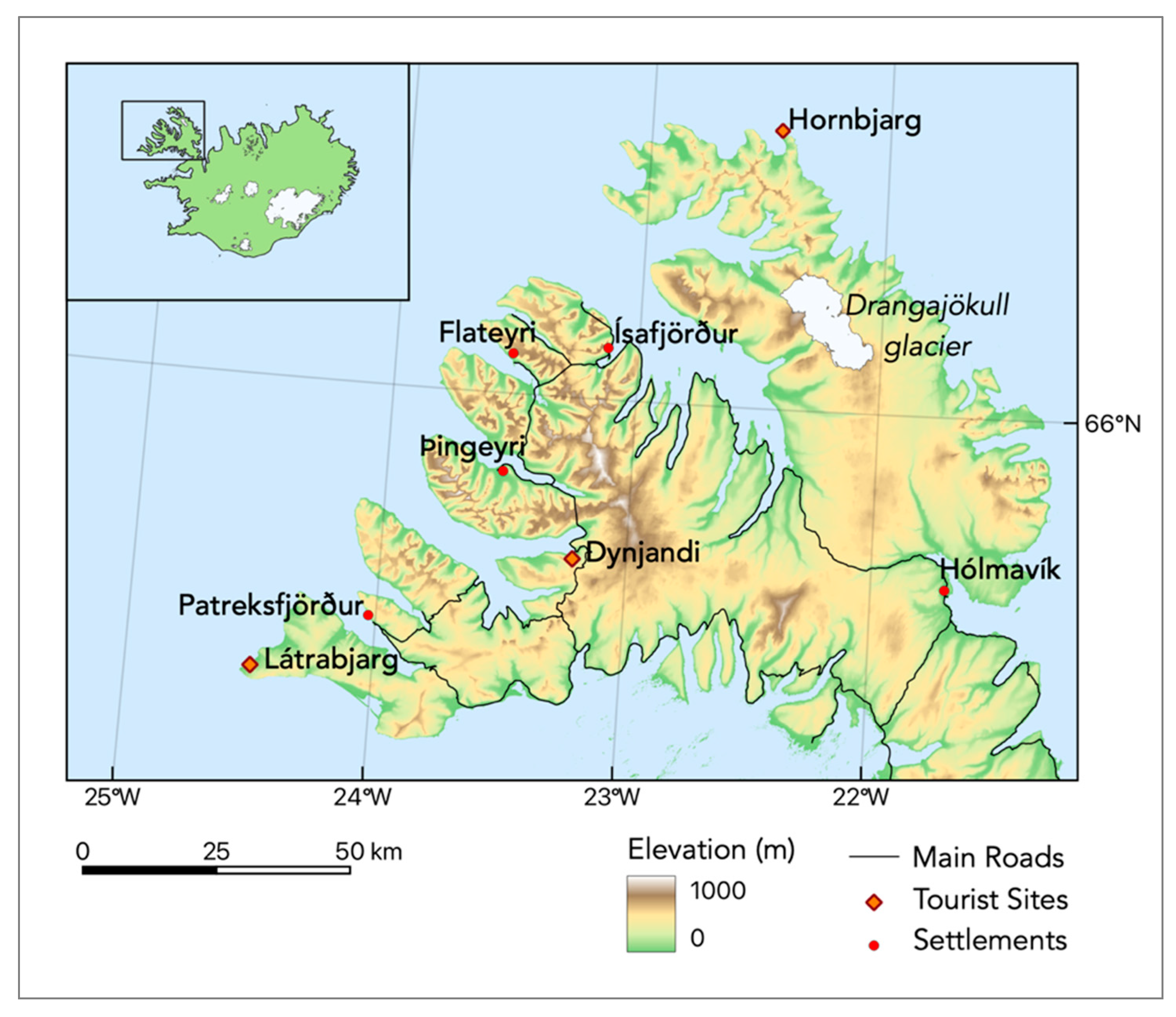
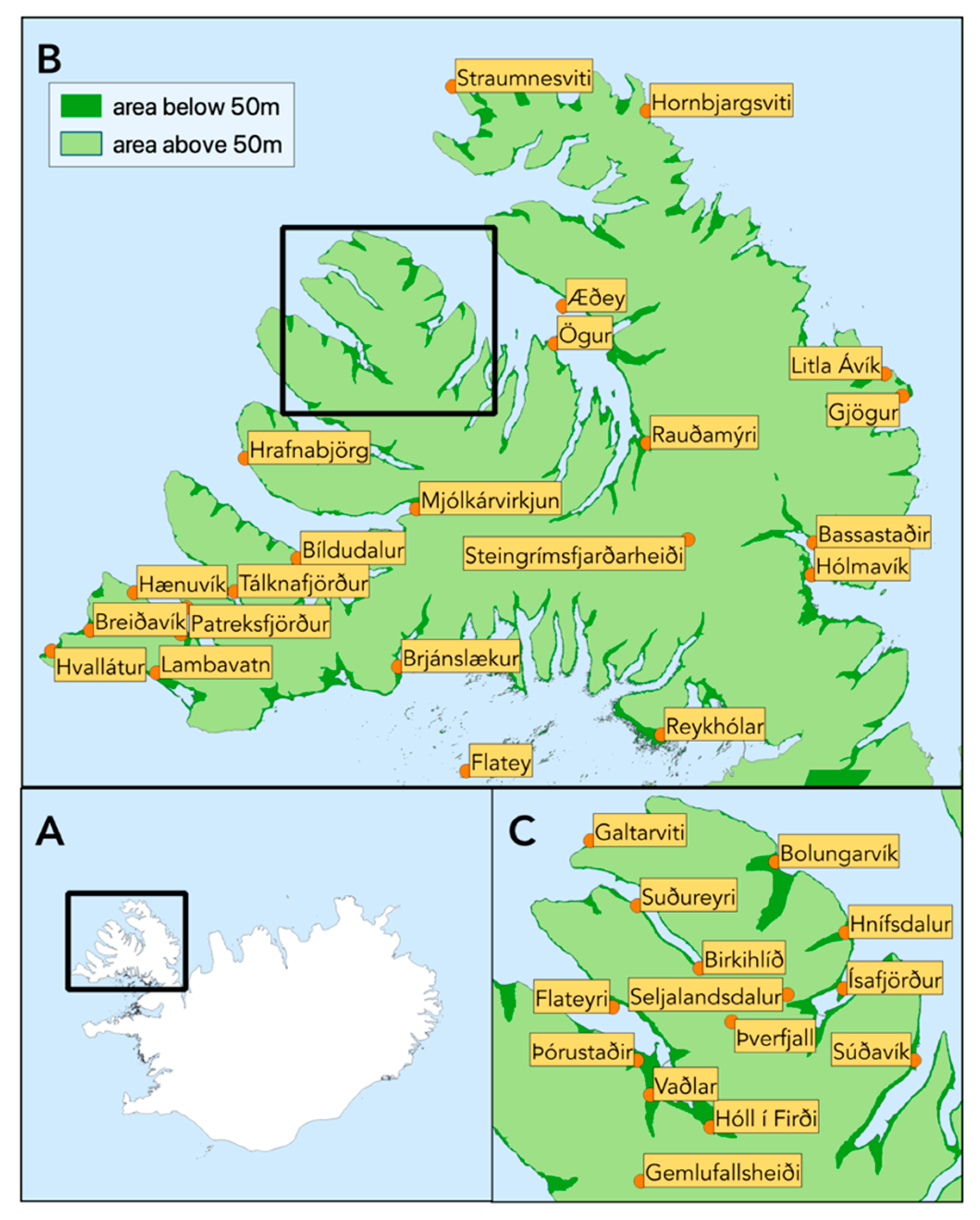
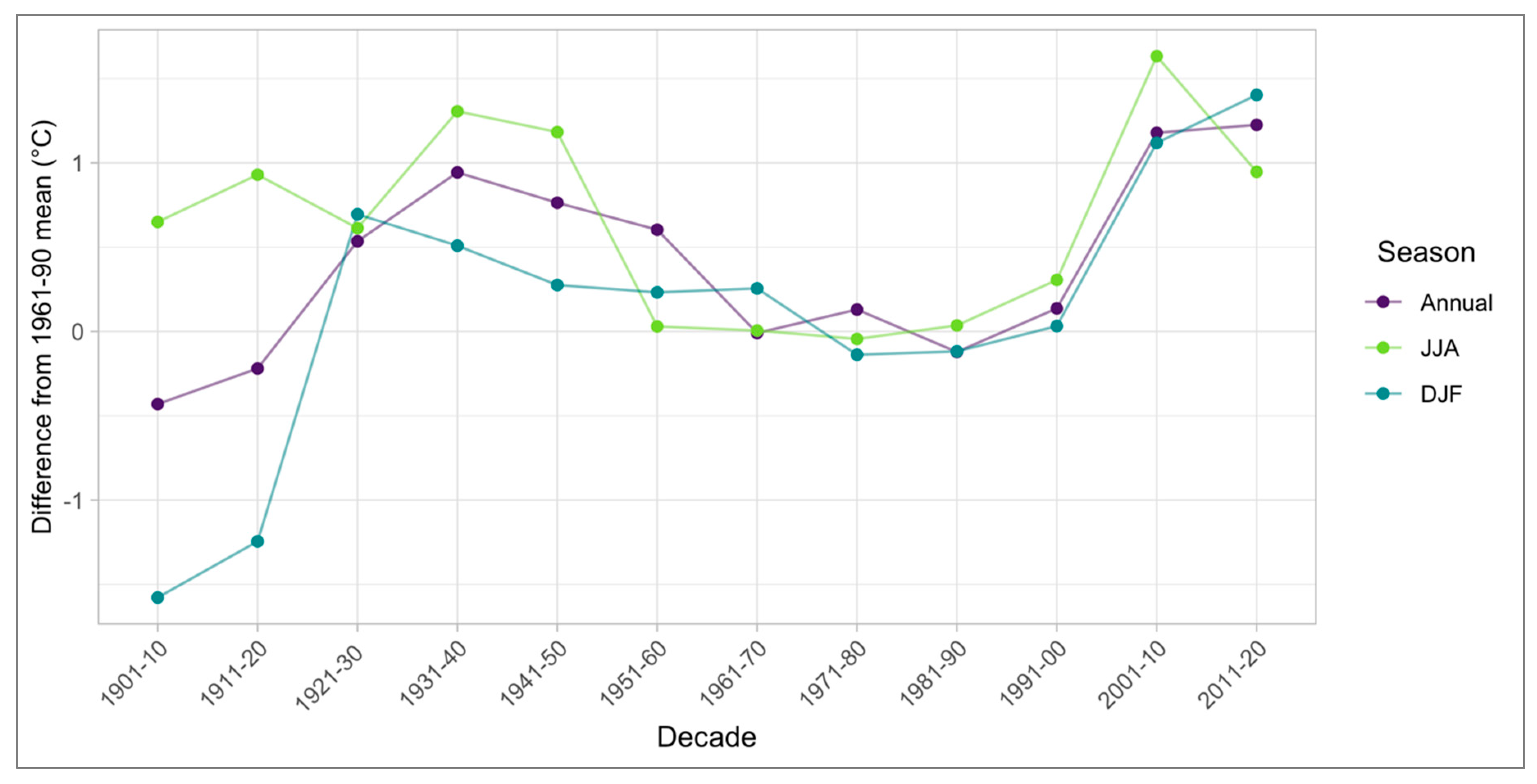

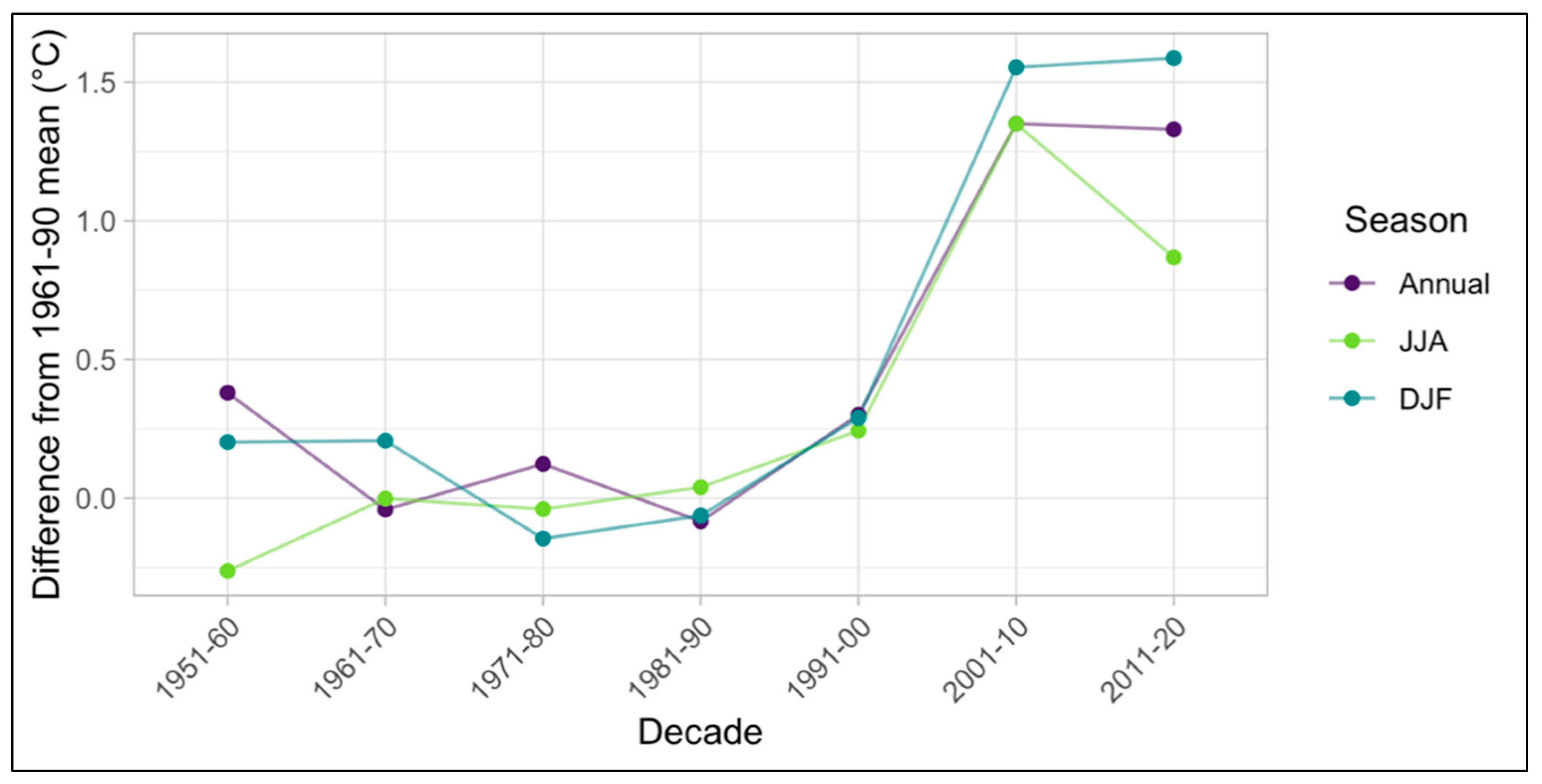

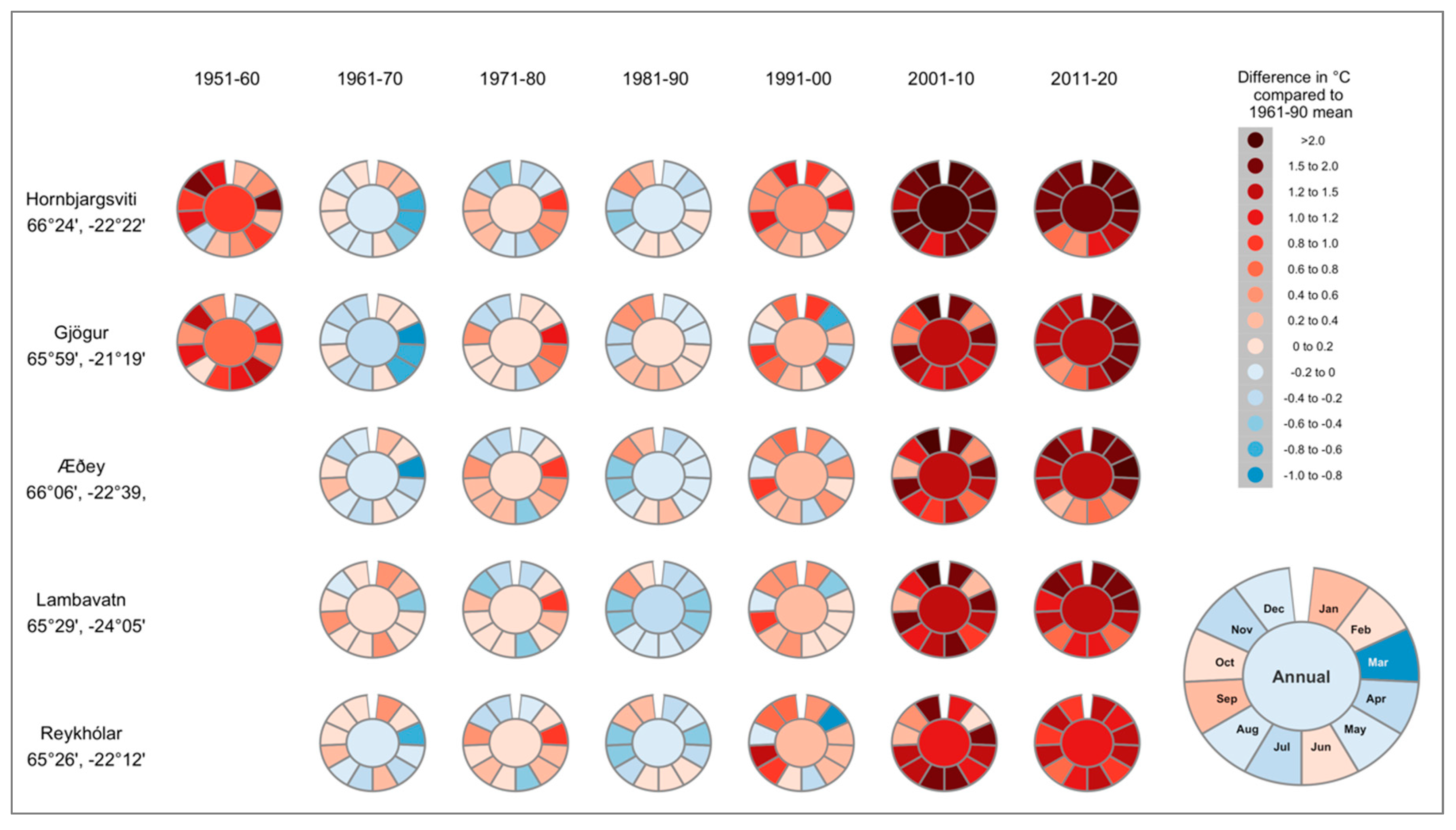
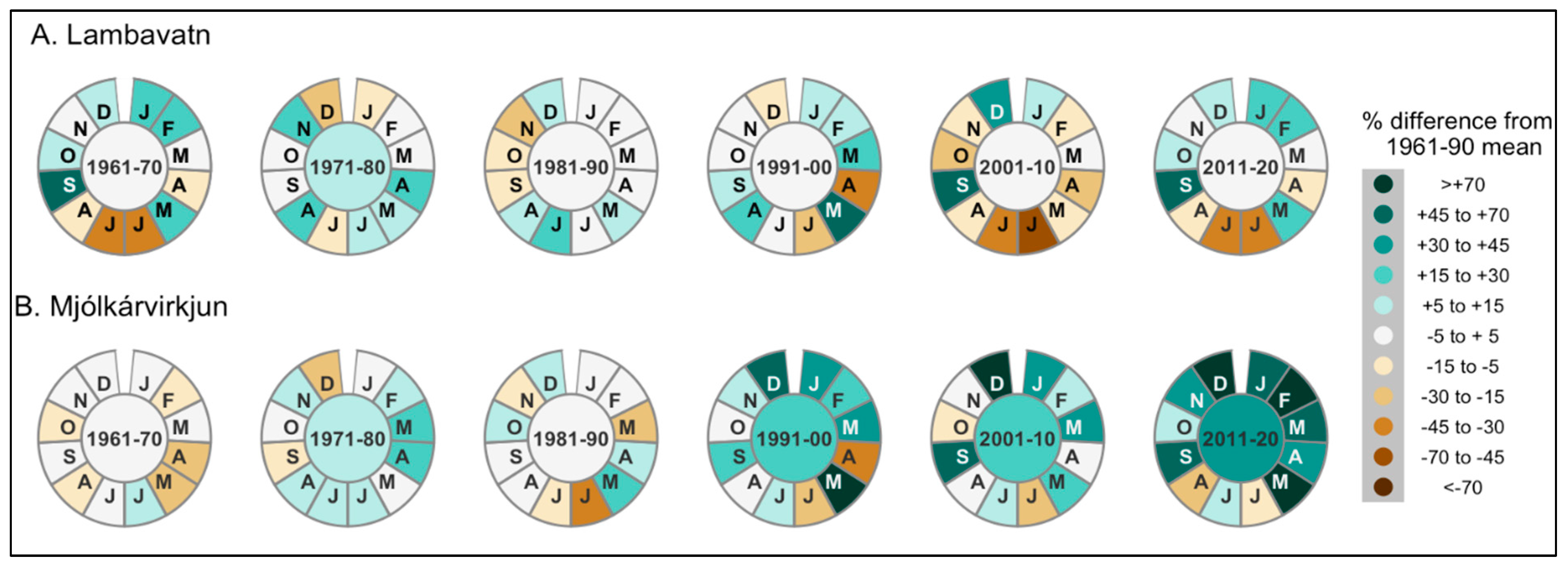
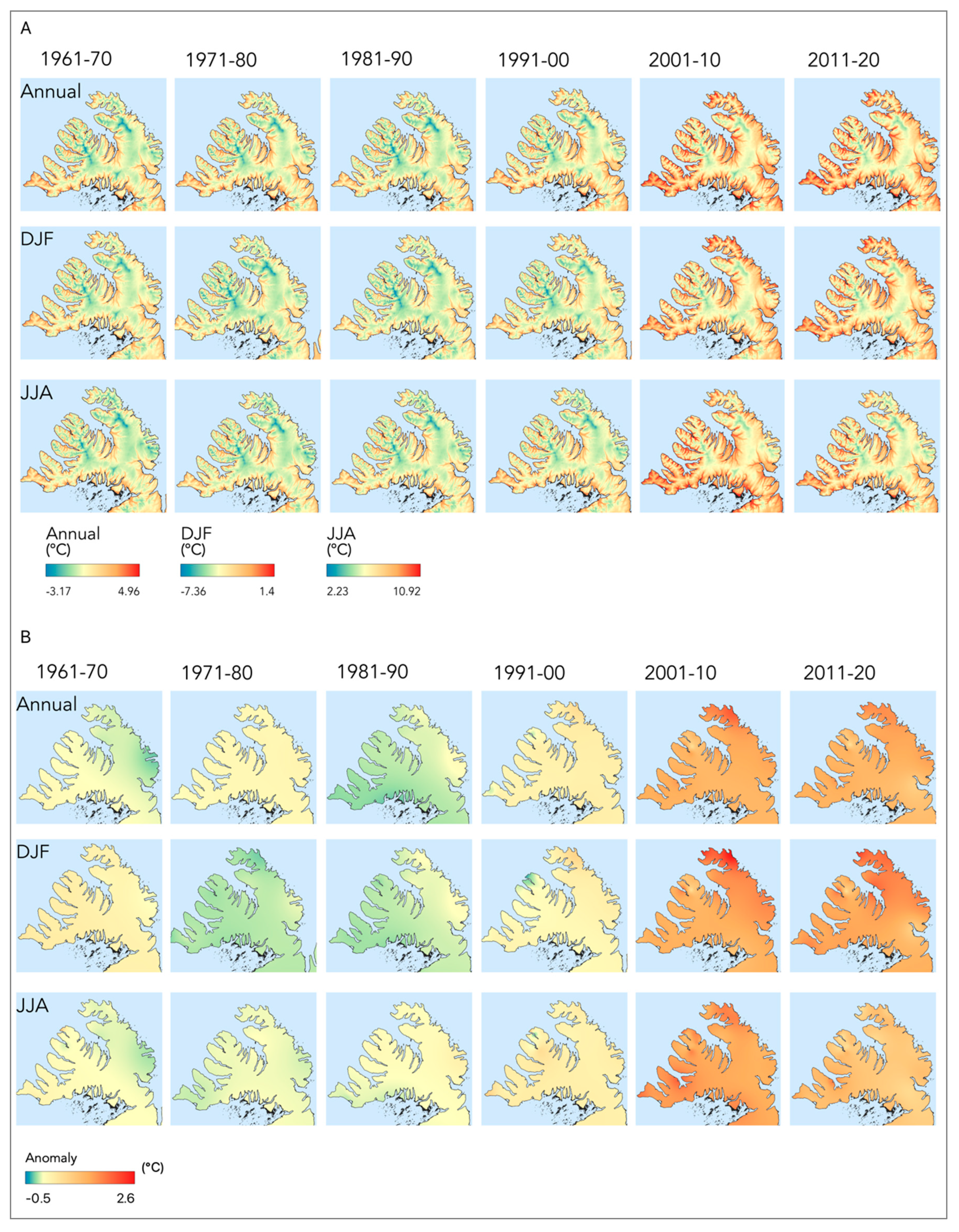
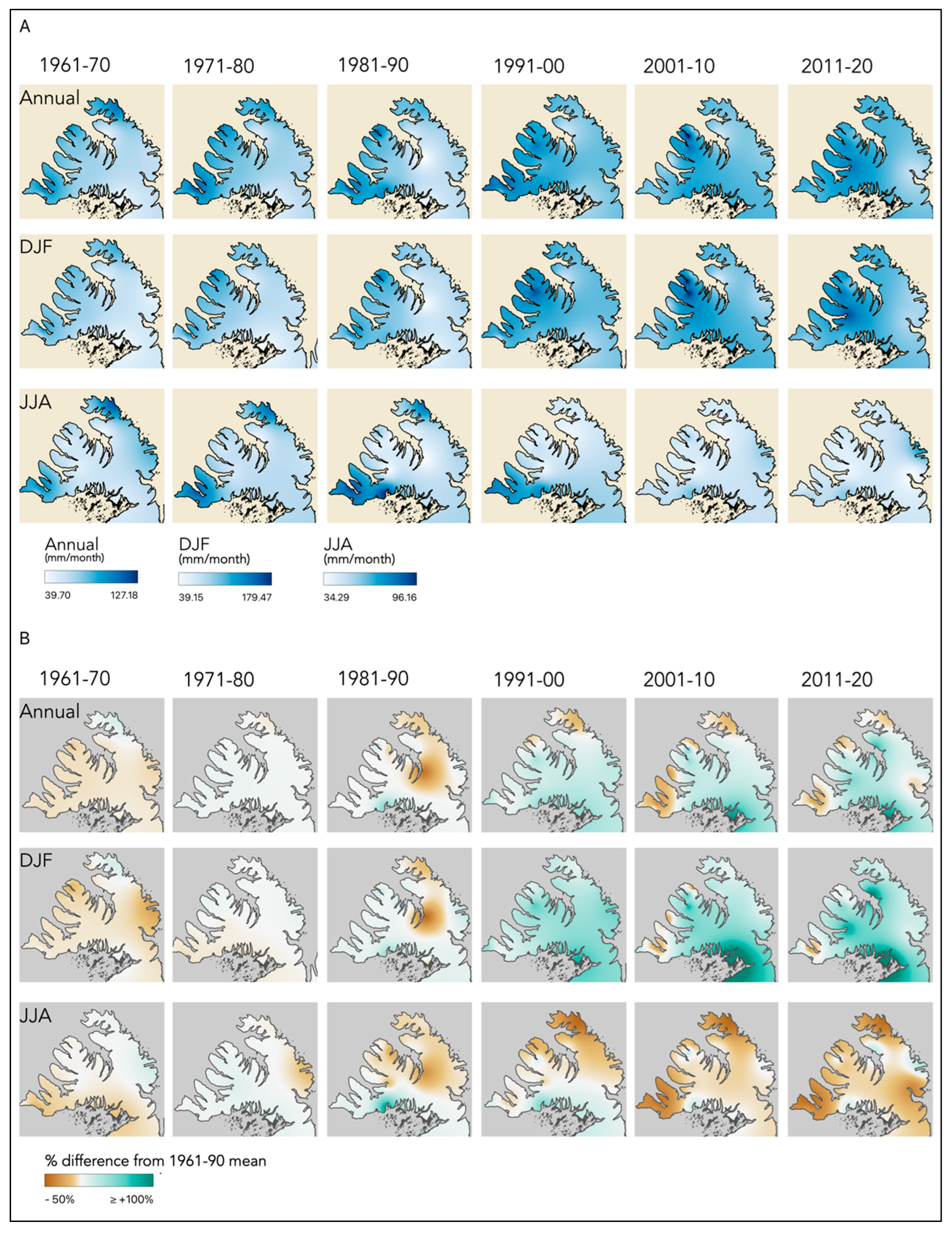
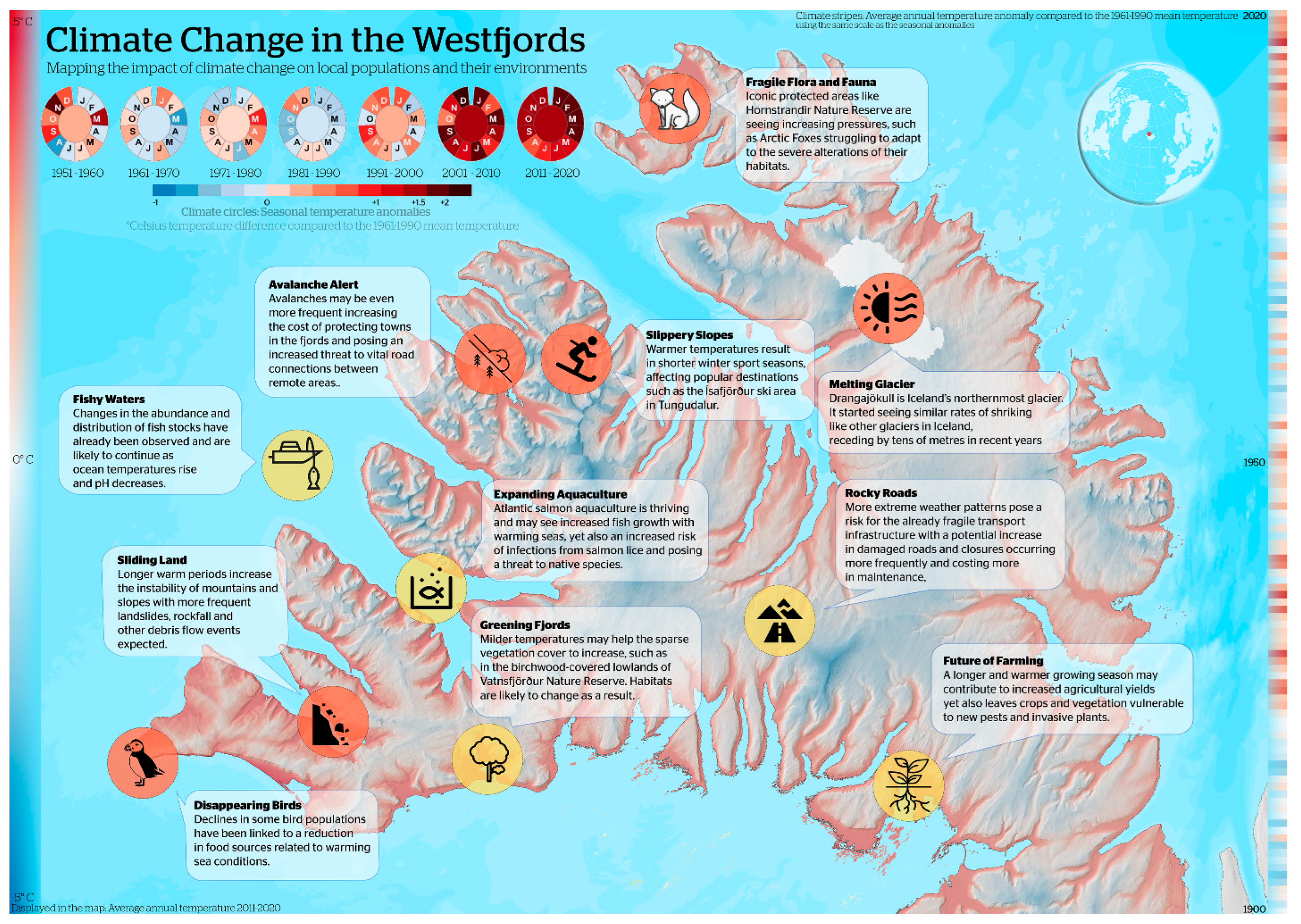

| # | Station | Elevation (m.a.s.l) | 1951–60 | 1961–70 | 1971–80 | 1981–90 | 1991–00 | 2001–10 | 2011–20 | 1961–90 1 | Temp | Precip |
|---|---|---|---|---|---|---|---|---|---|---|---|---|
| 1 | Bolungarvík | 18 | T 2 | T | T | T | T | X | X | T | 1898–2020 | 1995–2018 |
| 2 | Gjögur | 5/31 | X | X | X | X | T | T | T | X | 1949–2020 | 1949–1993 |
| 3 | Hornbjargsviti | 27/22 | X | X | X | X | T | T | T | X | 1949–2020 | 1949–1995 |
| 4 | Kvígindisdalur | 49 | X | X | X | X | X | X | 1949–2004 | 1949–2004 | ||
| 5 | Flatey | 3 | T | X | X | X | X | 1952–1989 | 1956–1989 | |||
| 6 | Reykhólar | 27 | X | X | X | X | T | T | X | 1961–2020 | 1961–2004 | |
| 7 | Æðey | 5/21 | X | X | X | X | X | T | X | 1954–2020 | 1954–2012 | |
| 8 | Lambavatn | 4 | X | X | X | X | X | X | X | 1961–2020 | 1961–2020 | |
| 9 | Mjólkárvirkjun | 8 | P | P | P | P | P | P | P | NA | 1959–2020 | |
| 10 | Þórustaðir | 20 | X | X | X | X | X | 1961–1998 | 1961–1998 | |||
| 11 | Suðureyri | 3 | X | X | X | X | 1961–1989 | 1961–1989 | ||||
| 12 | Galtarviti | 20 | X | X | X | X | 1953–1994 | 1953–1994 | ||||
| 13 | Hvallátur | 17 | X | X | X | X | 1953–1989 | 1953–1989 | ||||
| 14 | Ísafjörður | 2 | P | P | X | X | 1999–2020 | 1981–2020 | ||||
| 15 | Brjánslækur | 23 | P | P | P | P | NA | 1997–2020 | ||||
| 16 | Rauðamýri | - | P | NA | 1978–1989 | |||||||
| 17 | Hóll í Firði | 30 | X | X | X | 1983–2020 | 1983–2020 | |||||
| 18 | Breiðavík | 20 | X | 1990–2003 | 1990–2003 | |||||||
| 19 | Litla Ávík | 15 | X | X | 1996–2020 | 1996–2020 | ||||||
| 20 | Bíldudalur | 16 | X | X | 1998–2020 | 1998–2020 | ||||||
| 21 | Súðavík | 10 | X | X | 1996–2020 | 1999–2020 | ||||||
| 22 | Hnífsdalur | - | P | P | NA | 1995–2020 | ||||||
| 23 | Flateyri | 3 | T | T | 1997–2020 | NA | ||||||
| 24 | Þverfjall | 753 | T | T | 1994–2020 | NA | ||||||
| 25 | Ögur | 40 | T | T | 1997–2020 | NA | ||||||
| 26 | Straumnesviti | 7 | T | T | 1996–2020 | NA | ||||||
| 27 | Seljalandsdalur | 550 | T | T | 2001–2020 | NA | ||||||
| 28 | Steingrímsfjarðarheiði | 440 | T | T | 1995–2020 | NA | ||||||
| 29 | Patreksfjörður | 43 | T | T | 1996–2020 | NA | ||||||
| 30 | Birkihlíð | - | P | NA | 1998–2014 | |||||||
| 31 | Vaðlar | - | P | NA | 2000–2011 | |||||||
| 32 | Hrafnabjörg | - | P | NA | 1995–2012 | |||||||
| 33 | Gemlufallsheiði | 250 | T | 2010–2020 | NA | |||||||
| 34 | Tálknafjörður | 9 | T | 2009–2020 | NA | |||||||
| 35 | Hólmavík | 10 | T | 2008–2020 | NA | |||||||
| 36 | Bassastaðir | - | P | NA | 2005–2020 | |||||||
| 37 | Hænuvík | - | P | NA | 2005–2020 | |||||||
| TOTAL T | 5 | 12 | 12 | 12 | 10 | 18 | 21 | 12 | 28 | NA | ||
| TOTAL P | 3 | 12 | 12 | 15 | 10 | 14 | 12 | 12 | NA | 27 |
Publisher’s Note: MDPI stays neutral with regard to jurisdictional claims in published maps and institutional affiliations. |
© 2022 by the authors. Licensee MDPI, Basel, Switzerland. This article is an open access article distributed under the terms and conditions of the Creative Commons Attribution (CC BY) license (https://creativecommons.org/licenses/by/4.0/).
Share and Cite
Bannan, D.; Ólafsdóttir, R.; Hennig, B.D. Local Perspectives on Climate Change, Its Impact and Adaptation: A Case Study from the Westfjords Region of Iceland. Climate 2022, 10, 169. https://doi.org/10.3390/cli10110169
Bannan D, Ólafsdóttir R, Hennig BD. Local Perspectives on Climate Change, Its Impact and Adaptation: A Case Study from the Westfjords Region of Iceland. Climate. 2022; 10(11):169. https://doi.org/10.3390/cli10110169
Chicago/Turabian StyleBannan, Deirdre, Rannveig Ólafsdóttir, and Benjamin David Hennig. 2022. "Local Perspectives on Climate Change, Its Impact and Adaptation: A Case Study from the Westfjords Region of Iceland" Climate 10, no. 11: 169. https://doi.org/10.3390/cli10110169
APA StyleBannan, D., Ólafsdóttir, R., & Hennig, B. D. (2022). Local Perspectives on Climate Change, Its Impact and Adaptation: A Case Study from the Westfjords Region of Iceland. Climate, 10(11), 169. https://doi.org/10.3390/cli10110169






